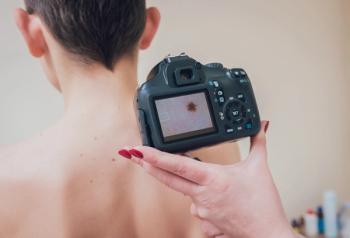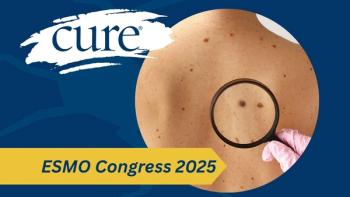
Learning Types of Skin Cancer and Who Is At Risk

Transcript:
Kristie L. Kahl: What are the different types of skin cancer?
Jeremy Brauer: We have to begin the conversation of cancer, and what that means. That means, regardless of the organ, you’re talking about uncontrolled growth of abnormal cells. In the case of the skin, most of that abnormality results from genetic alterations or damage to the DNA through ultraviolet light. Then, what type of skin cells are involved is what determines what kind of skin cancer specifically we’re talking about.
The most common skin cancer, and the most common cancer in the United States is basal cell carcinoma. The basal cells are found in the basement membrane, or the bottom most layer of the upper layer of the skin, or the epidermis. An overgrowth of these cells will result in basal cell carcinoma.
The second, what we call a non-melanoma skin cancer, is squamous cell carcinoma. Squamous cell carcinoma cells are found through the epidermis and they happen to be not only the second most common skin cancer, but also the second most common cancer in the United States.
The good news is with these two non-melanoma skin cancers, they have an exceedingly high cure rate when caught early and intervention is performed in early stages.
The third most common type of skin cancer is melanoma. Melanoma arises from the pigment-containing cells, known as melanocytes — they contain pigment or melanin. While these can result in a higher mortality rate, fortunately, in general, when melanoma is also caught early, or what we call in situ (the cells are only on the top layer of the skin or epidermis), they, too, have a similar cure rate to both of the non-melanoma skin cancers.
Kristie L. Kahl: What are the major differences between skin cancer and melanoma?
Jeremy Brauer: Melanoma in my mind, since it is derived from a skin cell, is a skin cancer. But we do break them up, in general, between non-melanoma skin cancers and melanoma.
So, the non-melanoma skin cancers, primarily basal cell and squamous cell carcinoma, make up the overwhelming majority of skin cancers. They are the most common. Fortunately, when identified and treated early, they have a high cure rate. Melanoma, similarly, if found early can have a high cure rate; however, if not, it ends up being deadlier than both basal can squamous cell carcinoma. To be sure, if left unchecked, both basal and squamous cell carcinoma can result in mortality as well.
Kristie L. Kahl: What are some common causes of the disease?
Jeremy Brauer: We believe almost 90% of all three of these skin cancers are really due to direct sun light, or UV (ultraviolet) damage). Basal cell and squamous cell carcinomas are a result of accrued sun damage over a lifetime. With melanoma, it’s more of (a result from) intermittent exposure or a history of sun burns. However, there is about 10% of individuals who wind up developing skin cancers unrelated to the sun. These are often found in areas that are not sun exposed. I think of these individuals as having some kind of underlying genetic predisposition, or a strong family history, or other underlying reasons as to why they develop these skin cancers.
Kristie L. Kahl: In non-melanoma skin cancer, how come these types of skin cancer become so advanced and what patients can look for to be proactive about screening?
Jeremey Brauer: As I had mentioned before, the good news is that when these are identified early — I think of prevention, detection, intervention – early intervention is key. Fortunately, when we do intervene as early as possible, the cure rates approach 90% to 100% in three of thede skin cancers. Unfortunately, if for one reason or another – if they’re not identified by the individual and brought to the attention of your dermatologist or they are neglected – they can and will cause both local damage in the case of non-melanoma skin cancer and there is a bigger propensity, for squamous cell particularly, to go outside or beyond the initial area of injury. Melanoma, on the other hand, has a much higher likelihood of spreading beyond the initial lesion. But again, if all three are caught early, cure rates are exceedingly high, approaching 99%.
Kristie L. Kahl: What in particular should people look out for?
Jeremy Brauer: In the past, we’ve talked about your ABCDE’s of melanoma, which are very important. I like to focus on the E, which is evolution. Really that can translate into identifying anything that is new, unusual or changing. The ABCD’s are:
- Asymmetry of a lesion
- Border Irregularity
- Color change
- Diameter of a certain size
In general, as I tell of my patients and friends and family, if there is something new on your skin or was already there and it’s changing or your feel as though it’s some sort of an unusual appearance — something about it rubs you the wrong way – it itches, stings or is burning, that warrants you bringing it to the attention of your dermatologist.
Kristie L. Kahl: Are there certain individuals at a higher risk for skin cancer?
Jeremy Brauer: Just like with most cancers and most diseases, there are populations of individuals who are at greater risk. We talked about sun exposure. Fair skinned individuals, light hair, light eyes who are more prone to sun burn because we do know individuals who have a history of sun burn, especially five or more over the course of their life, have a higher incidence of skin cancer, especially if they have those sun burns at a younger age.
Also, as I mentioned, individuals with a genetic predisposition. There are these diseases that, unfortunately, people can be born with where they are unable to repair damage to their DNA that is caused by ultraviolet light.
Another population is those who are immuno-compromised. So, those who have organ transplants and are required to be on immuno-suppressant medications tend to have a higher chance of developing these non-melanoma skin cancers and skin cancers in general.
Kristie L. Kahl: Most people think that skin cancer occurs in older adults, but can it happen in children, adolescents and young adults?
Jeremy Brauer: We just talked about who is more likely to develop skin cancer, but the truth of the matter is anyone and everyone can develop skin cancer. If you have skin and you have cells in your skin that can go awry with an abnormal collection of cells, then you can develop skin cancer. Obviously, certain individuals are at greater risk.
That does include children. Fortunately, it’s not a common thing to see skin cancer in children. Populations that we specifically want to make sure we follow more closely are individuals who have a family history, specifically a history of melanoma that increases you risk of developing melanoma significantly. Otherwise, if they are a pediatric oncology patient, or they require transplants, these are the individuals who we want to keep a close eye on.
In general, the pediatric population doesn’t develop many skin cancers.
Kristie L. Kahl: What is your biggest piece of advice for someone who is newly diagnosed with skin cancer?
Jeremy Brauer: My rule of three is early prevention, early detection and early intervention. If you see something new or unusual or changing. If someone has developed a skin cancer, it is taking that next step of getting all of the information you can. The best way to do that is to schedule an appointment with your board-certified dermatologist, discuss what the diagnosis means and what the expectations of the diagnosis are, and really review and identify the risks, benefits and alternative treatment options are for skin cancer.
Transcription edited for clarity.





